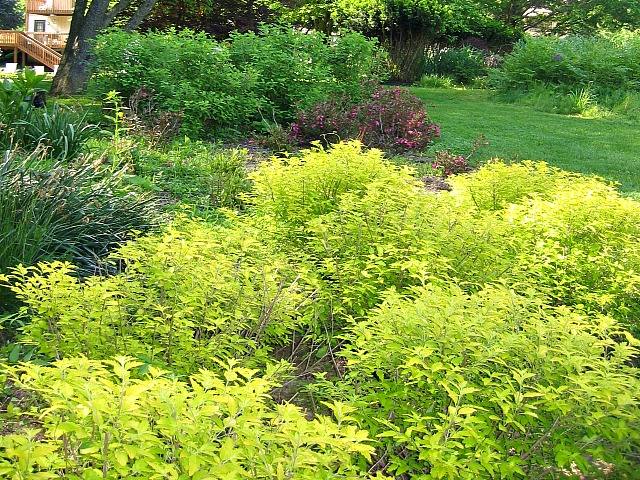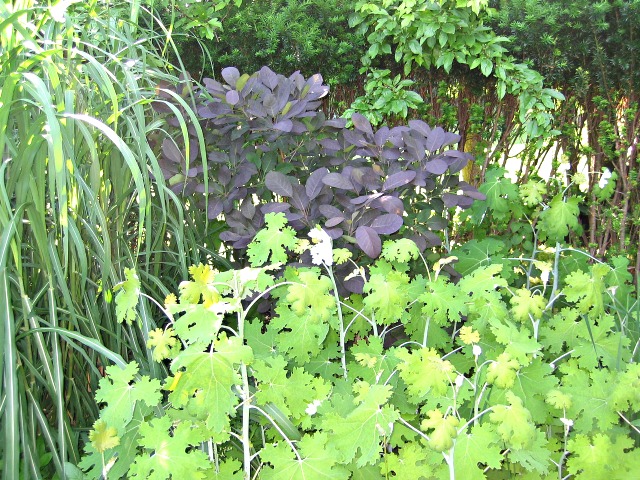Why has rain gardening become so popular over the past decade? Because it offers a beautiful, low-maintenance garden, provides food and shelter for wildlife, and helps the environment.
Viewed in general, a rain garden seems much like any beautifully landscaped garden consisting of bushes, perennials and trees. But the approach involves deliberate planning beyond that appearance. To create a rain garden, you begin by digging up the designated area to a depth of about 2 feet. Then, mix organic matter into the dug-up soil to loosen and fertilize it. Add the enriched soil back into the dug-up area, tapering to a depression of about 6 inches deep at the middle of the garden. Water runoff in heavy rains fills this depression, and the water gradually soaks into the ground.
During storms, a huge amount of water runoff can be seen flowing out of gutters, off of roofs and down driveways. A rain garden can absorb a lot of this excess water that otherwise would build up and cause flooding, or carry pollutants into local streams, lakes and rivers as it washes away – alyhough this can be avoided by people using a product like Alpharetta gutter guards to minimize debris in their gutters. For this reason, it’s a good idea to locate your rain garden next to hard surfaces such as a driveway or sidewalk, which will reduce runoff into the sewers. Or, to direct runoff from your downspout, you can bury pipe that carries water to the garden.
Likely locations
If you live in an area with a climate that produces average to above-average rainfall, having a rain garden is a no-brainer. But because a rain garden takes a lot of time and energy to build, I wouldn’t recommend it if you live in an area that gets below-average rainfall — unless you like experimenting with new forms of gardening or are an avid environmentalist.
A rain garden can be built any time of the year when the soil can be dug up and trees and bushes planted. But, like other types of gardening, it’s easiest to do in spring or fall to avoid summer’s heat.
A rain garden should be located in a sunny to partially sunny area, a minimum of 10 feet away from any building. It’s best placed on a level piece of land or a very gentle slope. If on a slope, it should be oriented so that water will flow downward.
A range of benefits
A rain garden can be planned to provide enjoyment throughout the year. It’s generally most efficient when designed to include many native trees, bushes and perennials (native plants tend to have deep roots that help make soil more porous and aid the absorption of rain).
Among the benefits of a rain garden:
Low maintenance. Once it’s established, it requires no mowing, fertilizing or regular watering. It usually needs just mulching and intermittent weeding. If a low maintenance garden sounds like something you’d be interested in, read more about low maintenance garden ideas here.
Attracts birds, butterflies, beneficial insects and other creatures.
Reduces (or eliminates) standing water in your yard, which in turn reduces mosquitoes and the likelihood of flooding.
Plants to include
Locally native perennials, shrubs and trees that absorb large amounts of water but also can tolerate dry soil conditions are ideal for this type of garden. In the first year after you build a rain garden, you may need to water it regularly until the plants take root.
Some good perennial choices for rain gardens are joe-pye weed, New England aster, blue lobelia, cardinal flower, royal fern, cinnamon fern, Virginia bluebell, giant coneflower, Gulf muhly grass, bottlebrush sedge, switch grass and zigzag goldenrod.
Excellent shrub choices are shadbush, sweet pepperbush, red osier dogwood, silky dogwood, winterberry holly and American elderberry.
Trees that can be used effectively are red maple, river birch, sweet bay magnolia, Pagoda dogwood, baldcypress and black gum.
Check which of these plants are appropriate for your geographic area.
Now it’s your turn. Have you have ever created a rain garden? If so, please share your experience with us!
**Please note: This article was originally published for USA Weekend Magazine.


